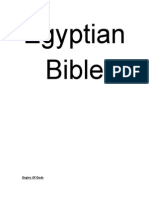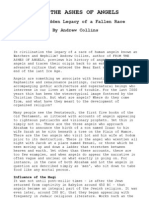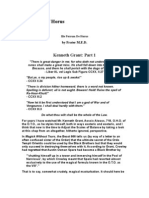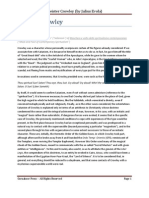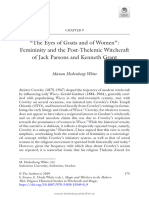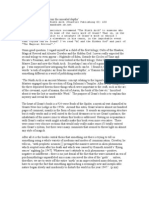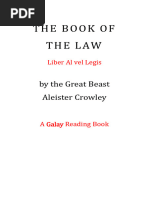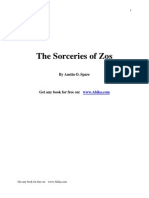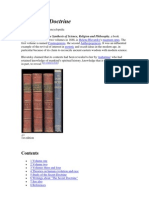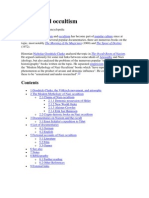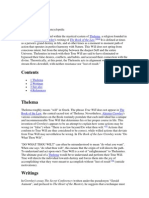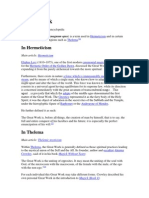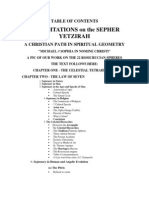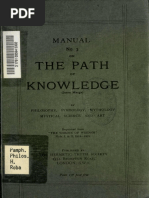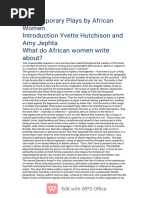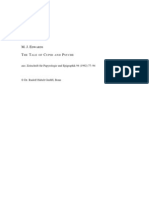Crowley, Sumeria and The Fallen Angels
Crowley, Sumeria and The Fallen Angels
Uploaded by
GnosticLuciferCopyright:
Available Formats
Crowley, Sumeria and The Fallen Angels
Crowley, Sumeria and The Fallen Angels
Uploaded by
GnosticLuciferOriginal Title
Copyright
Available Formats
Share this document
Did you find this document useful?
Is this content inappropriate?
Copyright:
Available Formats
Crowley, Sumeria and The Fallen Angels
Crowley, Sumeria and The Fallen Angels
Uploaded by
GnosticLuciferCopyright:
Available Formats
Crowley, Sumeria and the Fallen Angels
The following is an excerpt from a book forthcoming
By Vadge Moore
CHAPTER I Crowley and Jung
Aiwaz: On April 8th, 9th and 10th of the year 1904, English Magus Aleister Crowley n received a communication from a praeterhuman intelligence calling itself Aiwass or Aiwaz (pronounced eye was). This being announced to Crowley that it was the eye-was). minister of the Egyptian god Hoor tian Hoor-pa-Kraat, an aspect of the Egyptian sun god Kraat, Horus. Aiwaz revealed that Crowley was to be the prophet of a new aeon or era for mankind: the Aeon of Horus. Aiwaz proceeded to dictate to Crowley three chapters of a book later to be called The Book of the Law. This book discloses the pattern of a . coming age, a 2,000 year reign. A time of force, fire and blood. Of unparalleled freedoms and rampant chaos, a time not unlike our present age. The philosophy of this book came to be known as the Law of Thelema. Thelema is a Greek word Thelema. meaning will, and the True Will is at the center of Crowleys occult philosophy.
According to Crowley, this planet has already been through two previous ages of approximately 2,000 years each.
According to Crowley, this planet has already been through two previous ages of approximately 2,000 , years each. His reception of the Book of the Law marked the dawning of the third aeon. The first of these two preceding ages was called the Aeon of the Egyptian Goddess Isis. The Aeon of Isis represented a matriarchal, earth-bond age. Isis era can be seen in the cultures of ancient Greece and Rome. This was bond followed by the Aeon of Osiris , a patriarchal age that worshipped various gods in the form of the sun as a dying and resurrected deity. The beliefs of Christianity represent the culmination of this second age. surrected Aiwaz appeared to Crowley in order to announce the birth of the new aeon, the offspring of Isis and Osiris, Horus. As explained by Crowley, the Aeon of Horus is an epoch in which the inhabitants of earth
know that the sun does not die at night, pass through the Underworld only to be reborn at dawn. Instead it is seen as a great, fiery star that seemingly burns eternally as our individual spirits live eternally as well. Who or what was this Aiwaz? Where did he come from? Is there any evidence that he existed anywhere but in the mind of Aleister Crowley? Crowley describes Aiwaz as an Intelligence possessed of power and knowledge absolutely beyond human experience; and therefore Aiwaz is a Being worthy, as the current use of the word allows, of the title of a God Crowley proceeds to characterize Aiwaz as an intelligence praeterhuman and articulate purposely interfering in the philosophy, religion, ethics, economics and politics of the planetthe proof of his praeterhuman Nature call him a Devil or a god or even an Elemental as you will is partly external, depending on events and persons without the sphere of its influence Crowley writes But is there any Intelligence or Individuality (of the same general type as ours) independent of our human brain structure? For the first time in history, yes! Aiwaz has given us proof: the most important gate towards knowledge swings wideThis Book proves: there is a person thinking and acting in a praeterhuman manner, either without a body of flesh, or with the power of communicating telepathically with men and inscrutably directing their actions. In Crowleys book The Equinox of the Gods there is a long passage describing Aiwaz. The Voice of Aiwaz came apparently from over my left shoulder, from the furthest corner of the room. It seemed to echo itself in my physical heart in a very strange manner, hard to describeThe voice was of deep timbre, musical and expressive, its tones solemn, voluptuous, tender, fierce or aught else as suited the moods of the message. Not bass perhaps a rich tenor or baritoneThe English was free of either native or foreign accent, perfectly pure of local or caste mannerisms, thus startling and even uncanny at first hearingI had an impression that the speaker was actually in the corner where he seemed to be, in a body of fine matter, transparent as a veil of gauze, or a cloud of incense smoke. He seemed to be a tall, dark man in his thirties, well-knit, active and strong, with the face of a savage king, and eyes veiled lest their gaze should destroy what they saw. The dress was not Arab; it reflected Assyrian or Persian, but very vaguely. I took little note of it, for to me at that time Aiwaz was an angel such as I had often seen in visions, a being purely astral. I now incline to believe that Aiwaz is not only the God or Demon or Devil once held holy in Sumer, and mine own Holy Guardian Angel, but also a man as I am, insofar as he uses a human body to make his magickal link with Mankind As a footnote Crowley adds: I do not necessarily mean that he is a member of human society in quite the normal way. He might rather be able to form for Himself a human body as circumstances indicate, from the appropriate Elements, and dissolve it when the occasion for its use is past. I say this because I have been permitted to see Him in recent years in a variety of physical appearances, all equally material in the sense in which my own body is so.
While the description of this experience might sound rather odd and the reader might now be convinced that Mr. Crowley was desperately and hopelessly insane, there is a perfectly good explanation for this experience. It can be found in the work of Professor Carl Jung. Philemon: what he termed archetypes; mythological and religious symbols that can severely influence the conscious mind. Professor Carl Jung, Doctor of psychology, who posited the existence of a collective unconscious mind inhabited by what he termed archetypes; mythological and religious symbols that can severely influence the conscious mind. Jung had a experience very similar to Crowleys Aiwaz encounter. During the First World War, Jung had communications with a transpersonal entity named Philemon. In the book The Aryan Christ author Richard Noll writes, it is from discussions with Philemonthat Jung received his most profound insights about the nature of the human psyche. Philemon is described as a Gnostic-Mithraic guru that resides in what Jung called the Land of the Dead otherwise interpreted as the primordial Unconscious of Mankind. It was here, writes Noll, that Jung received instruction in the Law, the esoteric key to the secrets of the ages. This is very similar to Crowley receiving the Law of Thelema as propounded in the Book of the Law. Jungs visions of Philemon came to a head in 1916 when, Noll writes, The year 1916 rewarded years of tremendous dreams and visions that pushed him to the brink of insanity and suicide. He had been practicing a highly dissociative trance-induction technique that enabled him to travel to the realm of the gods and to talk to entities such as Philemon Jung called beings like Philemon Dominants of the collective unconscious. It was through contacts with Philemon that Jung was inspired to write his most controversial piece, The Seven Sermons to the Dead. According to Jung Biographer Deirdre Bair, Jung described Philemon as the pagan voice of an old man of simply superior knowledge. He believed Philemon was teaching him: psychological objectivity, the reality of the soul. He represented the dissociation between me and my imaginary object. Earlier, it used to be what I say, then it became a thing apart from me, and he personified this thing. He formulated this thing that was not me and expressed everything that I had not thoughtUntil the Seven Sermons, it was only said by him. Then it was demanded of me that I say it myselfThe Seven Sermons, that was when Philemon simply lost his absolute autonomy and I had to say it myself. The Seven Sermons to the Dead is a short work very similar to Crowleys Book of the Law in that it expresses a philosophy of balance wherein the opposites of dark and light, good and evil, God and Satan are united. In Crowleys work, his spiritual guide, Aiwaz, introduces Crowley to a host of different gods representing the philosophical dominants of the new era; Horus, Ra-hoor-Khuit, Hoor-pa-kraat, Nuit
and Hadit. Together they express a Nietzschean doctrine of strength, freedom and balance. For Professor Jung, Philemon introduces him to the Gnostic deity Abraxas. In the Seven Sermons to the Dead Jung writes, Abraxas is the god whom it is difficult to know. His power is the very greatest, because man does not perceive it at all. Man sees the supreme good of the sun, and also the endless evil of the devil, but Abraxas, he does not see, for he is undefinable life itself, which is the mother of good and evil alikeAbraxas is the sun and also the eternally gaping abyss of emptiness, of the diminisher and dissembler, the devil. The power of Abraxas is two fold. You can not see it, because in your eyes the opposition of this power seems to cancel it out. That which is spoken by God-the-Sun is life; that which is spoken by the Devil is death. Abraxas, however, speaks the venerable and also accursed word, which is life and death at once. Abraxas generates truth and falsehood, good and evil, light and darkness with the same word and in the same deed. Therefore Abraxas is truly the terrible one. He is magnificent even as the lion at the very moment when he strikes his prey down. His beauty is like the beauty of a spring morn. He is fullness, uniting itself with emptiness. He is the sacred wedding; He is love and the murder of love; he is the holy one and his betrayer. He is the brightest light of day and the deepest night of madnessAll things which you beg from God-the-Sun, generate an act of the devil. All things which you accomplish through God-the-Sun add to the effective might of the devil. Such is the terrible Abraxas. Abraxas looked as terrifying and as contradictory as he sounded. Ancient Greek talismans depict him as a rooster-headed deity with human arms and torso and a host of serpents for legs. He wields a whip and a shield and is usually driving a chariot. Philemon first appeared to Jung in a dream. Jungs method of initiation is called active imagination and it consists of taking a figure from one of your own dreams, closing your eyes and intensely visualizing this figure until it begins to move and speak of its own volition. This is very similar to the ancient western magical practice of ascending to the astral plane and engaging with beings there, something Crowley practiced extensively in his magical workings and in his contact with Aiwaz in particular. Bair writes, Jungs Philemon bore wings and floated like an angel, but his visage was nevertheless something demonicsomething Mephistophelean. Crowleys Aiwaz bares evidence of being both a god and a demon, as does Jungs Philemon. There is an age-old precedence for this experience. Its called the encounter with the daemon. There is an age-old precedence for this experience. Its called the encounter with the daemon. The ancient civilizations of Greece, Rome, Egypt, China and India believed in a whole host of fairies, satyrs and elementals. Manly P. Hall, in his magnificent tome, The Secret Teachings of All Ages writes, The Greeks gave the name daemon to some of these elementals, especially those of the higher orders, and worshipped them. Probably the most famous of these daemons is the mysterious spirit which instructed Socrates, and
of whom that great philosopher spoke in the highest terms. Hall quotes Thomas Taylors Apuleius on the God of Socrates, As the daemon of Socrates, therefore, was doubtless one of the highest order, as may be inferred from the intellectual superiority of Socrates to most other men, Aspuleius is justified in calling this daemon a God. It is also inferred here that Socrates daemon was responsible for his philosophical output, as were Crowleys and Jungs. It was initially believed that each person is in possession of two daemons; one good and one evil. As previously described, in both Crowley and Jungs experiences, the good and evil deities appear to be combined into one entity, in keeping with their non-dualistic approach. True Will: Crowley and Jung had their own methods for initiation which will be discussed separately prior to revealing the similarities between the two approaches. Crowley and Jung had their own methods for initiation which will be discussed separately prior to revealing the similarities between the two approaches. In Aleister Crowleys system of Magick the initiate is instructed to utilize the ancient Hebrew symbol system known as the Qabalah. Incorporating eastern yogic practices of breath control, concentration and visualization the neophyte is to ascend to the astral plane, utilizing his body of light and slowly ascend the paths as illustrated in the Qabalistic glyph known as the Tree of Life. This includes encountering the various entities that are situated on the paths and reside in the spheres called the Sephirah. Each encounter is a kind of test for the initiate, whose ultimate goal is to ascend to the very top of the Tree of Life and achieve supreme enlightenment. Midway through this journey it is imperative that the initiate encounter--what Crowley termed--the Holy Guardian Angel. This Angel is a being particular to each person, as individually fitted to the initiate as his shoe size or finger print. Once this Angel has been encountered the students journey becomes more natural, more significant. This Angel is the Genius latent in every individual. Crowley writes, The first step is the separation of (what we call, for convenience) the astral body from the physical body. As our experiments proceed, we find that our astral body itself can be divided into grosser and subtler components. In this way we become aware of the existence of what we call, for convenience, the Holy Guardian Angel, and the more we realize the implications of the theory of the existence of such a being, the clearer it becomes that our supreme task is to put ourselves into intimate communication with him. To further equate this Angel with the daemons of antiquity Crowley states, He [the Holy Guardian Angel] is a Person, a macrocosmic Individual. (We do not know about his birth and so on; but that is because he is, so to speak a private God; he only appears to the world at all through some reference to him by his client; for instance, the genius or Augoeides of Socrates.) Concerning instruction Crowley writes, you must remember that your Holy Guardian Angel is not only far more fully instructed than yourself on every point that you can conceive, but you may go so far as to say that it is definitely his work, or part of his work; remembering always that he inhabits a sphere or plane which is entirely different from anything of which you are normally aware.
Crowley continues,To attain to the Knowledge and Conversation of the Holy Guardian Angel is consequently without doubt by far the simplest way by which you can yourself approach that higher order of being. Once the initiates Holy Guardian Angel has been engaged, then does the True Will of the individual become apparent. In this passage from Crowleys own Commentary to the Book of the Law he refers to the this daemon as the Silent Self in each person, So also our own Silent Self, helpless and witless, hidden within us, will spring forth, if we have the craft to loose him to the Light; spring lustily forward with his Cry of Battle, the Word of our True WillsThis is the Task of the Adept, to have the Knowledge and Conversation of His Holy Guardian Angel, to become aware of his nature and his true purpose, fulfilling them. Crowley warns his readers that, unless you know what your true Will is, you may be devoting the most laudable energies to destroying yourself. In a passage similar to the writings of Carl Jung, Crowley writes, Unite the conscious will with the true Will, and the conscious Ego with the Silent Self. In Jungian terms the same thing is done when a patient unites his ego consciousness with the Transcendent Self or the collective unconscious. Individuation: Carl Jungs method of individuation is a process by which a persons conscious self or ego becomes aware of the primordial substrata of the collective unconscious of humanity, its forms, figures, gods, demons, heroes and myths. Carl Jungs method of individuation is a process by which a persons conscious self or ego becomes aware of the primordial substrata of the collective unconscious of humanity, its forms, figures, gods, demons, heroes and myths. These figures and forms are energetic patterns that deeply affect the thoughts, feelings and behavior of individuals. These patterns, called archetypes, are usually unconscious to the waking ego, leaving the ego completely unaware of their influence. Individuation occurs when the ego consciously integrates these patterns through dream analysis and what Jung termed active imagination. Jung explains, As the archetypes, like all numinous contents, are relatively autonomous, they cannot be integrated simply by rational means, but require a dialectic procedure, a real coming to terms with them, often conducted by the patient in dialogue form, so that, without knowing it, he puts into effect the alchemical definition of the meditatio: an inner colloquy with ones good angel. Usually the process runs a dramatic course, with many ups and downs. It expresses itself in, or is accompanied by, dream symbols that are related to the representations collectives, which in the form of mythological motifs have portrayed psychic processes of transformation since the earliest times. Individuation is described by Jungian author Edward Edinger as The conscious realization and fulfillment of ones own unique being. It is associated with typical archetypal imagery and leads to the experiencing of the Self as the center of personality transcending the ego. It begins with one or more decisive experiences challenging egocentricity and producing the awareness that the ego is subordinate to a more comprehensive psychic entity. This is very concurrent with Crowleys ritual methods of invoking a particular god and merging with that deity. The ego is temporarily usurped as the god takes control. As a pattern of the archetypal realm the god is challenging the initiates egocentricity and giving the ritualist
a taste of the larger Self. As this is done repeatedly with various god forms the ego resonates more and more to the Self and becomes conscious of its true individuality or True Will. The True Will is the ultimate goal of the Crowley magician just as individuation is the desired result for the Jungian patient. Similar methods are used in each system for identical ends. Active imagination is the ritual invocation of the Jungian. Edinger describes it thus: A technique for conscious dialogue between the ego and the unconscious whereby unconscious contents are integrated. Expanding upon this interpretation Jungian author Joan Chodorow writes, Jungs therapeutic method had many different names before he settled on the term active imagination. At first it was the transcendent function. Later he called it the picture method. Other names were active fantasy and active phantasying. Sometimes the process was referred to as trancing, visioning, exercises, dialectical method, technique of differentiation, technique of introversion, introspection, and technique of the descent. As strange as some of these terms sound active imagination consists of simply utilizing a figure from your dreams, a picture of a god or of any kind of character from culture or even fantasy and allowing your imagination to freely play with it. Jung suggests, looking, psychologically, brings about the activation of the object; it is as if something were emanating from ones spiritual eye that evokes or activates the object of ones vision. Once activated, this object takes on a life of its own and begins to interact with the viewer. This too, is how Crowley describes ascending to the astral plane and interacting with the denizens of that realm. Describing the astral body Crowley writes, This body, which is called by various authors the Astral double, body of Light, body of fire, body of desire, fine body, scin-laeca, and numberless other names is naturally fitted to perceive objects of its own class in particular, the phantoms of the astral plane. Littered throughout Jungs works are descriptions of processes that sound reminiscent of Crowleys method of the Knowledge and Conversation of the Holy Guardian Angel as to show no differentiation. For example, Jung writes, I have presented a series of dream-symbols of the process of individuation. They were dreams which without exception exhibited rebirth symbolism. In this particular case there was a long-drawn-out process of inner transformation and rebirth into another being. This other being is the other person in ourselves-- that larger and greater personality maturing within us, whom we have already met as the inner friend of the soul. Another aspect of Jungs method similar to Crowleys is the ability to talk to this friend or other, ask him pertinent questions and receive answers, You need not be insane to hear his voice. writes Jung, On the contrary, it is the simplest and most natural thing imaginable. For instance, you ask yourself a question in which he gives answer. The discussion is then carried on as in any other conversation. You can describe it as mere associating or talking to oneself, or as a meditation in the sense used by the old alchemists, who referred to their interlocutor as aliquem alium internum, a certain other one, within. Some people frequently experience this other inside of their self and explain it away as rogue associations or stray thoughts. These explanations allow the ego to maintain its belief in its own superiority, saving the ego from being drowned in the murky waters of the unconscious. Magick and
Individuation are both practices that allow the ego access to these primordial realms without overwhelming the individual personality. The final similarity between these two initiatory methods is the belief in separate ages or aeons. Weve already covered Aleister Crowleys belief in the three aeons of Isis, Osiris and the current age of Horus. Jung had tapped this belief as well. He writes, there exist universal ideas of world periods, critical transitions, gods and half gods who personify the aeons. The unconscious naturally does not produce its images from conscious reflections, but from the world wide propensity of the human system to form such conceptions as the world periods of the Parsees, the yugas and avatars of Hinduism, and the Platonic months of astrology with their bull and ram deities and the great fish of the Christian aeon. In regards to this last aeon Jung writes, the present aeon of the Fishes is drawing to its end the Fish, as we know, represents Christ and the aeon of Osiris. This idea of different aeons lasting approximately 2,000 years each is not newor original. This idea of different aeons lasting approximately 2,000 years each is not new or original. Manly P. Hall writes, The period of 2,160 years required for the regression of the sun through one of the zodiacal constellations is often termed an age. According to this system, the age secured its name from the sign through which the sun passes year after year as it crosses the equator at the vernal equinox. From this arrangement are derived the terms The Taurian Age, The Aryan Age, The Piscean Age, and the The Aquarian Age. During these periods, or ages, religious worship takes the form of the appropriate celestial signthat which the sun is said to assume as a personality in the same manner that a spirit assumes a body. Crowley presents these aeons differently, yet they still mean the same thing. The Aryan Age is the age of Isis, the Piscean age the age of Osiris and the Aquarian age the Aeon of Horus. In fact, Jung posited his belief that that this coming or current age will be an age in which the opposites are conjoined, in which good and evil are seen as relative to each other and not in opposition. Jung saw developing, a religious attitude that was destined to bridge and compensate the frightful gulf that had opened out between Christ and Antichrist in the eleventh century. In Jungs work Christ and Satan are not in opposition. Indeed they are brothers representing the two halves of dark and light much like the Chinese symbol of yin-yang does. In the Piscean/Osirian age the dark and light, Christ and Satan are opposed to one another. But, as Jung states, If, as seems probable, the aeon of the fishes is ruled by the archetypal motif of the hostile brothers, then the approach of the next Platonic month, namely Aquarius, will constellate the problem of the union of the opposites. It will then no longer be possible to write off evil as the mere privation of good; its real existence will have to be recognized. In a book that was received through Aiwaz, Liber XC, Crowley expresses the same sentiment as Jung stating; Many have arisen, being wise. They have said Seek out the glittering Image in the place ever golden, and unite yourselves with it. Many have arisen, being foolish. They have said, Stoop down into the darkly splendid world and be wedded to that Blind Creature of the Slime. I who am beyond Wisdom and Folly, arise and say unto you: achieve both weddings! Unite yourselves with both! Beware, beware, I say lest you seek after the one and lose the other! My adepts stand upright; their head above the heavens,
their feet below the hells. But since one is naturally attracted to the Angel, another to the Demon, let the first strengthen the lower link, the last attach more firmly to the higher. Thus shall equilibrium become perfect. I will aid my disciples; as fast as they acquire this balanced power and joy so faster will I push them. While Jung writes, Christ is followed by the Antichrist, at the end of time, how curious it is that the aeon following the age of Christ has allegedly been ushered in by a man calling himself The Great Beast 666, Aleister Crowley. We are going to find a slight discrepancy in the time periods, as explained by Crowley, of the succession of the aeons. The aeon of Isis, we will find, was much older then the civilizations of Greece and Rome. In fact it was quite mature prior to the civilization of ancient Egypt. Its home was Sumeria. Crowley has stated that he believed his daemon Aiwaz was originally a god or demon once worshipped in the ancient civilization of Sumeria. We will now explore this fascinating antique culture and see how this may be so.
CHAPTER II The Fallen Angels
Sumeria: The Sumerians were a highly developed culture in terms of agricultural, architectural and artistic production; they created the oldest form of written language and the first formal education system. The civilization of Sumeria sprang up approximately 5,000 years ago located in what is currently known as Iraq. The Sumerians were a highly developed culture in terms of agricultural, architectural and artistic production; they created the oldest form of written language and the first formal education system. Occult author Boyd Rice writes, Sumeria is the oldest civilization known to man. Long before Greece and Rome had attained their golden age, Sumeria was already ancient. Those in search of the roots of early history often go back to the glory days of the pharaohs of Egypt, yet Egypt too was in its infancy at a time when Sumeria had long been the center of the world. For all intents and purposes, Sumeria seems to have entered the world stage as a high civilization. It wasnt there, and then suddenly it was complete with arts, sciences, astronomy, navigation, agriculture and all the complexities of a highly-evolved culture. All of which leaves the modern observer to ponder exactly how such a society could appear out of nowhere and nothing into such a fully realized entity, seemingly instantaneously. Rice adds, ancient Sumeria seems to have leap-frogged over and beyond the baby steps of civilization; a feat never since repeated in the annals of mankind. How did they do it? Their explanation is quite simple and straightforward: they were taught everything they knew by a race of gods. These gods appeared in Sumeria with a fully formed mature civilization and imparted their knowledge to the local inhabitants of the Middle East. But where had these gods come from? Where had they
developed their knowledge? One answer to these questions can be found in the work of a little known early twentieth century Sumerologist, Lawerence Austine Waddell or L.A. Waddell (1854-1938). His work has been dismissed and ignored for nearly a century due to his belief in the superiority of the Aryan race. However, the writers prejudice notwithstanding, his work has revealed cultural patterns and clashes that have occurred in the ancient Near East. According to an introductory biography, Waddell was a medical officer in the Indian government service, traveler and orientalist. Waddells interest in Buddhism led him to explore India; its people and its customs. Later he studied Tibetan Buddhism and wrote two classics on the subject, The Buddhism of Tibet and Lhasa and its Mysteries. After his retirement, Waddell directed his attention towards defining the relationship between India and Sumeria. Waddell believed that he had uncovered proof that these talented Sumerians were actually ancient Europeans that had spread out over Europe, the Middle East, Egypt and the Indus valley carrying with them their knowledge of civilization. This was in contradistinction to the then popular belief that the Sumerians were either of Semitic or unknown origin. According to Waddells research these Europeans were so shockingly different to the Middle Eastern inhabitants, and their store of knowledge so vast and advanced, that they came to be known as gods. According to ancient Hebrew myth these gods subsequently coupled with the local female population. This had a terrific impact on the culture, religion and lives of these indigenous people. The Apocryphal text The Book of Enoch reveals a tradition of a host of fallen angels that were believed to have bred with the daughters of men. This is found in the Old Testament as well, where it is written in Genesis 6, And it came to pass, when men began to multiply on the face of the earth, and daughters were born unto them. That the Sons of God saw the daughters of men that they were fair; and they took them wives of all which they choseThere were giants in the earth in those days; and also after that, when the Sons of God came in unto the daughters of men, and they bare children to them, the same became mighty men which were, of old, men of renown. In the myths of the ancient Hebrews it is these Sons of God that become known as the Watchers. They are the angels of God that have grown attracted to the daughters of men and proceed to mate with them and hence breed monstrous offspring called Nephilim. These offspring are described as of a giant stature and unusual complexion. In The Book of Enoch, Enoch speaks of the strange birth of his grandson Noah: After a time, my son Mathusala took a wife for his son Lamech. She became pregnant by him and brought forth a child, the flesh of which was as white as snow, and red as rose; the hair of whose head was white like wool, and long; and whose eyes were beautiful. When he opened them, he illuminated all the house, like the sun; the whole house abounded with light. And when he was taken from the hand of the midwife, opening also his mouth, he spoke to the Lord of righteousness. Then Lamech his father was afraid of him; and flying away came to his own father Mathusala, and said, I have begotten a son unlike to other children. He is not human; but, resembling the offspring of the angels of heaven, is of a different nature from ours, being altogether unlike to us. His eyes are bright as the rays of the sun; his countenance glorious, and he looks not as if he belonged to me, but to the angels. As is clearly stated in this text, Lamechs son Noah is the offspring of the angels or the Watchers, the Sons of God. These offspring do become men of renown. In his book The Makers of Civilization, Waddell writes, And the Sons of God who married the daughters of men in the Hebrew legend are
seen to have been obviously thesons or descendants of the King Adam. Waddells writing reveals what he believes to be the real historic identity of Adam, Eve and all of the antediluvian figures from the Old Testament as well as the true identities of Jehovah, Jupiter, Zeus, Thor, Bacchus, Lucifer, Osiris, Isis, Set, and interestingly for our purposes, Horus, as being based on the heroes, villains and Sumerian Kings of antiquity. Having spent many years studying ancient Indian texts Waddell began to notice similarities between the names of the ancient Indian Kings and the Kings of Mesopotamia, and the chronology of their reign. In Waddells earlier work he had seemingly proven the identity of the Sumerians as an advanced ancient European culture. By poring over documents and records of various civilizations he identified a common thread in the names of a very long line of kings. He writes, This identity of these Kingsis complete, not only in respect of their names and titles, but also as regards their exact chronological position and order of succession and in the achievements of the leading Kings throughout this very long period of over two millenniums of yearsan overwhelming proof of identity unparalleled perhaps elsewhere in the annals of History. These extensive records list a long line of ancient European rulers, these rulers names, titles and real historical tales, allegedly revealing them to have been the legendary templates for the gods, heroes, kings, queens, monsters and devils of following civilizations. Waddell writes, The epoch-making first king himself, the traditional builder of the first city and founder of civilization, which changes the whole history of mankind, has his whole personality and achievements preserved in considerable circumstantial detail in the numerous early representations of him, and in the celebrations of his fame and his benefactions to humanity in Sumerian literature, and in the Indian chronicles and Vedas and in the great Gothic epics of the Nordics, the Eddas, and for these benefactions he was latterly canonized and deified. Waddell proposes that the heroic mythology from nearly every race and culture has its origin in real historic figures from the ancient world. He writes, A vast deal of what has hitherto been looked upon as prehistoric and mythical becomes historic and real. Heroes who have been raised into gods again take form as men, and as historic earlyKings of relatively fixed dates. Gods and demi-gods of the ancient Greeks and Romans, Egyptians and Hittites, Persians and Aryans, as well as of the Goths, Scandinavians and Germans, Ancient Britons, Irish and Anglo-Saxons And, Waddell here fails to mention, the Hebrews. Jungian author Edward Edinger expresses this possibility in his book The Eternal Drama, Where do myths come from? The psychological view is that they emerge progressively from the collective unconscious and gradually, by the collective endeavor of the race, are worked over and embodied in some durable form. But from almost the beginning this question has come up: do they not rather express the residue of some historical reality? Edinger further states, As far back as the third or fourth century BC, a man named Euhemerus put forth the idea that myths are derived from historical happenings, and that all heroes, for instance, were once actual kings or personages. Waddell makes an immense claim, but provides detailed textual material to back up his findings. Additional aspects of Waddells work, which has special significance for our present study, includes a re-
appraisal of the Germanic Poetic Edda with its tales of Odin, Thor, Loki, Freya, and Baldur. According to his subsequent book, The British Edda Waddell reveals that the Poetic Edda was a misrepresentation of a more ancient text regarding the Sumerian Kings and conquerors. In this earlier text is told the historic tale of King Dar, Tar or Thor, who is the leader of this conquering people not, as recounted in the later Poetic Edda, Odin (otherwise known in the later Poetic version as Wodan or Wotan). In the Poetic Edda, King Dar or Thor is misrepresented and separated into two gods Odin and Thor. In the Sumerian text Dar or Thor is described as the leader of a Sun-worshipping race. In the Sumerian history, Budun (Wodan or Wotan) is the enemy of King Dar and faces him in battle in this original ancient tale. In Waddells British Edda Wodan is described as being one of the leaders of a Serpent-Moon cult along with Wodans evil Mother-Weird as she is described in the text. This matriarchal figure seems to be a strange combination of mother/lover-consort to Wodan. Her name is El and she is the matriarch queen of this serpent-cult. The male offspring of Wodan and El is called Baldr-Sutt or Baldr-Abel. The text depicts the battle between these opposing cults. In this recovered text it is described how King Dar finds a mate for himself from among the Serpent-Moon cult. Her name is Ifo, Guen-Ever or Eve and, as Waddell explains she is of the same sea-faring, sun worshipping people as Dar and was kept as a ward by El, the serpent queen. Dar and Ifo bring forth a son named Crown Prince Kon, Gunn or Kan, later known as Cain in the Bible. From these Sumerian texts Waddell believed he saw the emergence of certain archetypal patterns that will later become the figures of myths and legends. For instance the Serpent-cult leaders El and Wodan, when fused together, are the template for what will later become the Egyptian and Greek evil serpent-beast Typhon. Their son Baldur-Sutt is the precursor to the dark, infernal Egyptian god Set. Sun-lord King Dar and his consort Ifo are translated as the Egyptian god and goddess Osiris and Isis, as well as the first man and woman depicted in the Biblical legend, Adam and Eve. Most importantly their son Prince Kon, (Gunn, Kan or Cain), in an interesting twist on the Biblical legend of Cain and Abel, becomes the good prince while the Serpent Prince Baldr-Sutt or in his other title Baldr-Abel, becomes the bad figure. This then makes Prince Kon, (Gunn, Kan or Cains) Egyptian equivalent the god Horus, the god presiding over Crowleys new aeon. Watcher Motifs In the Sumerian sealstranslated by WaddellKing Dar was frequently depicted as a bird-man or accompanied by a falcon or a hawk. In the Sumerian sealstranslated by WaddellKing Dar was frequently depicted as a bird-man or accompanied by a falcon or a hawk. The hawk, later associated with Prince Kon who, Waddell believed, emerges in Egyptian myth as the hawk-headed god Horus, was also an Egyptian icon for the sun. This symbolism emphasizes the solar attributes and identities of these people as sun-worshippers. They were generally depicted with horned headdress making them appear goat-like and are seen on many ancient seals in the presence of goats. The word Goat, according to Waddell was synonymous with Goth, meaning the ancient Gothic people of which these solar conquerors were descended. King Dar is revered in these seals as the champion of the Goats or Goths. Waddells book, The Makers of Civilization
shows an illustration of a seal from approximately 2500 B.C. depicting the deified first king as In-dur, showing him bearded with his Goat and Bull emblems and Gothic horned headdress of self and votaries. On these seals serpents represent the Snake-Moon cult of the local inhabitant matriarch El. King Dar is often depicted taming or battling these serpents. In the book From the Ashes of Angels author Andrew Collins explores the subject of the Watchers and, presumably without knowledge of Waddells obscure texts, discovers precisely the same depictions. In Collins research these people are represented as birdmen and goat-men. Collins writes, the goat wouldappear to have been one of the primary totemic symbols of the Watchers. Writing specifically of Azazel, one of the fallen angels that appear in the Book of Enoch Collins states, Azazels chosen form was the goat, and in this capacity he had also been the ruler of a monstrous race of demons named the seirim, or he-goats. They are even mentioned in the Bible and were worshipped and adored by some Jews. There is even an indication that women had actually copulated with these goatdemons for it states in the Book of Leviticus: And they shall no more sacrifice their sacrifices to the hegoat (seirem), after whom they go a-whoring, perhaps a distant echo, once again, of the way in which the Watchers had taken wives from among mortal kind. This clear relationship between the Watchers and hegoats was so strong that it led the Hebrew scholar J.T. Milik to conclude that Azazel was evidently not a simple he-goat, but a giant who combined goat-like characteristics with those of men. Collins examines a stamped seal from ancient Iran showing anthropomorphic goats controlling serpents and vultures. Collin asks, Do these goat demons preserve some memory of the advanced shamanistic culture thought to be behind the accounts of angels and Watchers in Judeo-Christian tradition? Collins goes on to quote Edith Porada, author of Early Mesopotamia and Iran, who stated, the evidencesuggests that there was an early concept of a creature or creatures, which combined the features of goat and powerful bird in a manner unknown to us; that the human figure with the horned animal head on stamps of the Ubaid Period was a powerful, shamanistic demon capable of warding off serpents. This mythical warding off serpents seems to depict the real history of King Dar of the SunHawk cult, wearing his typical horned headdress battling the Serpent-Moon cult of Wodan-El and BaldrSutt or Set. Based on Waddells research on the Sumerian seals and cuneiform texts we read these symbols as representing the form of religious worship that came most naturally to each group. One group worshipped the sun; their leaders donning horned headdresses as a symbol of their royalty. The sun was their lord and was worshipped as the All-Father and giver of life. The other group worshipped the moon and the serpent, the serpent representing the cycles of nature in the continual shedding of its skin. The moon is generally a symbol of the female sex and was reverenced and invoked by this matriarchal society. We can see how the symbolism of these two cults merged, in Crowleys estimation, as the Aeon of Horus, the child of the matriarchal and patriarchal ages. Waddell explains how the Serpent-Matriarch cult was predominant before the invasion of the Sun worshippers. After the solar cult superceded the previous paradigm the symbolism of both were combined to accommodate the conquered peoples. Later the symbolism of the goat, bird, and serpent were synthesized to represent precisely this adaptation. The union of these two cults gave birth to chthonic symbolism; the serpent rising out of the earth terminating in a lions head, the ancient symbol of the solar force. This icon of a lion-serpent is explored in Crowleys
Book of the Law in which it is described as, the Secret Self of every man, the Serpent with the Lions Head. In that context it represents the True Will of the initiate. Also, the Abraxas figure combines the solar icon of the rooster head with the serpent feet. Furthermore, the goat and serpent symbols can be seen, specifically, but perhaps unintentionally, on the Baphomet; the pentagram goat-head token used by the Church of Satan. The outer edge of this emblem spells out Leviathan, the serpent, in Hebrew. Yezidi Devil-God Crowley identified Aiwaz as a god, demon, or devil that had once been worshipped in Sumeria; the god worshipped by the Yezidi. Crowley identified Aiwaz as a god, demon, or devil that had once been worshipped in Sumeria; the god worshipped by the Yezidi. According to the Frater Superiour of the current Ordo Templi Orientis (an occult order once headed by Crowley), Like their relatives the Kurdish Chaldeans, the Yezidis (or Yazidis) are a cultural survival of older Mesopotamian cultures. The principal Yazidi deity is named Melek Taus. They were termed Shaitan-worshippers (i.e., devil-worshippers as a pejorative term by their hostile Arab neighbors.). In his book From the Ashes of Angels Andrew Collins writes, The appellation of devil worshippers had been given to the Yezidis yet their creed ventured far beyond such an ignorant description. The name Yezidi derived from the nature of their beliefs, which focused primarily around an indigenous breed of angelic beings. In many ways their name can be translated as the angelicans, and originally this would appear to have been the name by which the Kurdish angel cults were known. Yet chief among the Yezidi angels was a unique and very important figure indeed. His name was, and still is (for the Yezidis still exist) Melek Taus, the Peacock Angel. He corresponds with the Judeo-Christian concept of the Evil OneSatan or LuciferBut this association hardly does him justice, for Meleck Taus is seen as a supreme being, with authority over human affairs. This is very similar to Crowleys description of Aiwaz as a being that appears to have great insight into and control of human affairs. The Yezidi are in possession of a holy book known as the Black Book supposedly dated--in its present form-- around the 13th century A.D. According to Collins this book states, the first name of the Peacock Angel had been Azazil, an Arabic rendering of Azazel, one of the leaders of the Watchers in Judeo-Christian apocrypha. More intersestingly, in The British Edda Waddell identifies Azazel with Prince Kon, Cain, or his Eyptian identity, Horus. We will recall that in Crowleys prophetic book The Book of the Law, Aiwaz is described as being the minister of Hoorpa-Kraat, the passive aspect of the god Horus. With Crowley identifying Aiwaz as the god of the Yezidis, known to scholars as Melek Taus or Azazel and Waddells research revealing Azazel as the Sumerian Prince, Kan, Cain, or Horus of Egyptian lore, we can now identify Aiwaz as an agent or an aspect of this ancient Sumerian real-historic Prince Kan. Further confirmation of the identification of Horus with the Watchers comes from the findings of Egyptologist Walter Bryan Emery. Andrew Collins sites Emerys discovery of late pre-dynastic graves in northern Egypt as containing the bodies of a race of great stature believed to have founded the royal line of EgyptEmery identified them with the Shemsu-Hor, the
companions, or followers of the hawk headed god Horus. Collins further writes of Emery, he was hawk-headed therefore implying that the most distant ancestors of the Egyptians had been tall in stature with large craniums. Waddell described them as lo headed. The same skulls were found buried in early long-headed. Sumerian graves. Also similar was the unique architecture in Sumer and Egypt showing a distinct relationship between the two cultures. To remind the reader; in Biblical and Apocryphal texts the Sumerian royalty were described as Sons of Sumerian God, angels or Watchers; fallen angels after coming in unto the daughters of men. I wondered if Crowley had ever mentioned the Watchers in his work and soon discovered that he had. In a letter to the American automobile maker Henry Ford, Crowley beseeches Ford to embrace his Thelemic religion and le the Law of Do What Thou Wilt. Regarding the Watchers, Crowley writes, there occur from time to time certain crises in the affairs of men which compel them [the Watchers] to act in concert, and to select and send forth one of their number to put publicly forward such portions of their secret doctrine as will enable men to solve the current problem which baffles them, and to triumph over the dangers which beset them round. Two and twenty years ago, such a situation reached its climax. It was already evident to the Watchers that all the sanctions which had served humanity for guidance had lost their compelling force. According to Crowley, all of the myths and legends of the past were no longer strong enough to keep humanity in check. Crowley explains, The Watchers in silence understood that the time had come for them to take action. They foresaw that men left guideless and incapable of wisdom would plunge into the madness of the world war, and all its consequences of aimless unrest. They [the Watchers] saw that the one way to save the race from such red ruin as has overwhelmed civilizations of the past was to send forth a Man with a Message. That Man was, of course, Aleister Crowley and Aiwaz was that Watcher that we Crowley now have identified from ages past. In the Equinox of the Gods Crowley wrote of his attempted rejection of Aiwaz and the Book of the Law. Regardless of his repudiation, Again and again the unsleeping might Law. of the Watchers drove him (Crowley) back to the work The work is the spread of the Law of tchers Thelema and the contents of The Book of the Law. The Fallen Angels or Watchers appear to be primordial Law. archetypes that periodically bubble up from the cauldron of humanitys racial unconscious. Certain humanitys sensitives like Crowley seem to have superiorly attuned psyches that can interpret these messages as they stream up from the depths of the unconscious mind. Now, as interesting as this line of inquiry into the origins of C Crowleys Devil-God Aiwaz has been, this is God not the only interpretation. The previous explication emphasized the Solar Cult attributes but the subject Solar-Cult of our next inquiry will be the Typhonian Mother Mother-Weird Serpent-Cult of the destructive demon Set. The Cult modern-day exponent of these dark mysteries is Crowley disciple Kenneth Grant who utilizes, to great day effect, the work of Egyptologist Gerald Massey. According to Grant, Aiwaz origins do not reside in the Solar-Cult. Aiwaz is, rather, a denizen of the Serpent pantheon. Cult.
Copyright-2005.
Bair, Deirdre: Jung; A Biography, Back Bay Books, Little Brown & Company (New York-Boston: 2004) Collins, Andrew: From the Ashes of Angels, The Forbidden Legacy of a Fallen Race, Bear & Company (Rochester, UT: 1996) Crowley, Aleister: The Equinox of the Gods, New Falcon Press (Scottsdale, AZ: 1991, 1991 Ordo Templi Orientis) The Holy Books of Thelema, Samuel Weiser (York Beach, Maine: 1988) The Law is for All: An Extended Commentary on the Book of the Law, New Falcon Publications (Phoenix, AZ: 1993, 1993 Ordo Templi Orientis) Magick, Red Wheel/Weiser LLC (York Beach, ME: 2002) Magick Without Tears, New Falcon Publications (Tempe, AZ USA: 1997) The Revival of Magick and Other Essays, New Falcon Publications, Ordo Templi Orientis (Tempe, AZ: 1998, 1998 Ordo Templi Orientis) Edinger, Edward F.: Ego and Archetype, Shambala (Boston and London: 1992) The Eternal Drama, Shambala (Boston and London: 1994) Hall, Manly P.: The Secret Teachings of All Ages, Tarcher-Penguin (New York: 2003) Hoeller, Stephan A.: The Gnostic Jung & The Seven Sermons to the Dead, A Quest Book (USA, India, England: 1982) Jung, C.G., Aion, Princeton/Bollingen (1979) The Archetypes of the Collective Unconscious, Princeton/Bollingen (1990) Jung on Active Imagination, Edited with an Introduction by Joan Chodorow, Princeton University Press (Princeton, New Jersey: 1997) Noll, Richard: The Aryan Christ; The Secret Life of Carl Jung, Random House (New York, NY: 1997) Prophet, Elizabeth Claire: Fallen Angels and the Origins of Evil, Summit University Press (Corwin Springs, Montana: 2000) Rice, Boyd: The First Eden, http://www.rosenoire.org/articles/www.thevesselofgod.com (Boyd Rice 2004) That Which Has Fallen, http://www.rosenoire.org/articles/www.thevesselofgod.com (Boyd Rice 2004) Waddell, L.A.: The British Edda, Christian Book Club (Hawthorne, CA: 1930) Egyptian Civilization its Sumerian Origin and Real Chronology, Christian Book Club (Hawthorne, CA: 1930) The Makers of Civilization, Luzac & Co. (London, England: 1929) Excerpts from the Holy Bible taken from the King James version.
You might also like
- Witchcraft A Beginners Guide PDFDocument131 pagesWitchcraft A Beginners Guide PDFMarina Junqueira95% (20)
- The Satanic BibleDocument15 pagesThe Satanic BibleGnosticLucifer64% (25)
- Kenneth Grant - Beyond The Mauve ZoneDocument203 pagesKenneth Grant - Beyond The Mauve Zonej7817747100% (1)
- Peter Levenda - Stairway To HeavenDocument324 pagesPeter Levenda - Stairway To Heavenkenichi shukehiro100% (12)
- Overthrowing the Old Gods: Aleister Crowley and the Book of the LawFrom EverandOverthrowing the Old Gods: Aleister Crowley and the Book of the LawRating: 3 out of 5 stars3/5 (6)
- Egyptian BibleDocument22 pagesEgyptian Biblepsychoboiii100% (2)
- Homo Serpiens: An Occult History of DNA from Eden to ArmageddonFrom EverandHomo Serpiens: An Occult History of DNA from Eden to ArmageddonRating: 4 out of 5 stars4/5 (3)
- Starfire2 PDFDocument119 pagesStarfire2 PDFKinguAmdir-Ush89% (9)
- The Sethian Gnostic Book of ElelethDocument7 pagesThe Sethian Gnostic Book of ElelethEdmundDante0% (1)
- The Angel & The Abyss: The Inward Journey, Books II & IIIFrom EverandThe Angel & The Abyss: The Inward Journey, Books II & IIIRating: 4 out of 5 stars4/5 (14)
- Rites of the Mummy: The K'rla Cell and the Secret Key to Liber ALFrom EverandRites of the Mummy: The K'rla Cell and the Secret Key to Liber ALRating: 1 out of 5 stars1/5 (1)
- From Ancient Egypt To The Qabbalah: The Great TransmissionDocument22 pagesFrom Ancient Egypt To The Qabbalah: The Great TransmissionliayaNo ratings yet
- Typhonian KemetDocument17 pagesTyphonian Kemetliaya76100% (3)
- Babalon & The BeastDocument92 pagesBabalon & The BeastApollonius 4=7100% (5)
- The Key of The AbyssDocument358 pagesThe Key of The Abyssemiliano_croce100% (7)
- The Covenant of SamyazaDocument8 pagesThe Covenant of SamyazaJamés LövattNo ratings yet
- The Chimera Androgyne The Esoteric Mystique of Baphomet and AbraxasDocument27 pagesThe Chimera Androgyne The Esoteric Mystique of Baphomet and Abraxasaccrassus100% (5)
- From The Ashes of AngelsDocument34 pagesFrom The Ashes of AngelsSaundra100% (3)
- The QlippothDocument9 pagesThe Qlippothindigorutz100% (2)
- John Dee and the Empire of Angels: Enochian Magick and the Occult Roots of the Modern WorldFrom EverandJohn Dee and the Empire of Angels: Enochian Magick and the Occult Roots of the Modern WorldRating: 4.5 out of 5 stars4.5/5 (24)
- Review of The Law Is For All (1976)Document15 pagesReview of The Law Is For All (1976)Herbert Slomski II100% (1)
- Esoteric NazismDocument18 pagesEsoteric NazismGnosticLucifer100% (2)
- Black SunDocument11 pagesBlack SunGnosticLucifer75% (8)
- Thelemic MysticismDocument13 pagesThelemic MysticismGnosticLucifer100% (1)
- Goddess Cults in EgyptDocument368 pagesGoddess Cults in EgyptLeslie100% (5)
- Fish SymbolismDocument6 pagesFish SymbolismGanOn JungianNo ratings yet
- Queen, Mother, Wise Woman and Lover - Rediscovering The Archetypes of The Mature FeminineDocument19 pagesQueen, Mother, Wise Woman and Lover - Rediscovering The Archetypes of The Mature FeminineMiruScribd100% (3)
- Carl Olson The Book of The Goddess Past and Present An Introduction To Her Religion PDFDocument248 pagesCarl Olson The Book of The Goddess Past and Present An Introduction To Her Religion PDFElora Tribedy100% (7)
- David Beth - Aleister Crowley and The Dawn of AiwassDocument11 pagesDavid Beth - Aleister Crowley and The Dawn of AiwassCrabStar100% (6)
- The Dark Lord: H.P. Lovecraft, Kenneth Grant, and the Typhonian Tradition in MagicFrom EverandThe Dark Lord: H.P. Lovecraft, Kenneth Grant, and the Typhonian Tradition in MagicRating: 4 out of 5 stars4/5 (13)
- John Dee - EquinoxDocument33 pagesJohn Dee - Equinoxdelius12012No ratings yet
- Grant - Introduction To The Book of Pleasure (English)Document4 pagesGrant - Introduction To The Book of Pleasure (English)Емил КендеровNo ratings yet
- Turn On, Tune In, and Trance OutDocument55 pagesTurn On, Tune In, and Trance OutRaymond SassuNo ratings yet
- The False Prophet AzazelDocument1,100 pagesThe False Prophet AzazelJohnoftheGentiles93% (30)
- KennethGrant TheSwordOfHorusDocument60 pagesKennethGrant TheSwordOfHorusM Gloria-divine Turner86% (7)
- Nagas - The Trans-Human Sources of Tantric Serpent SymbolismDocument44 pagesNagas - The Trans-Human Sources of Tantric Serpent SymbolismLex Taylor90% (10)
- The Dark SunDocument59 pagesThe Dark SunFay Of FictionNo ratings yet
- Star RubyDocument8 pagesStar RubyGregoryPeters100% (3)
- Aleister Crowley - The Enochian TabletsDocument31 pagesAleister Crowley - The Enochian TabletsAstralSageNo ratings yet
- Lucifer RisingDocument5 pagesLucifer RisingLuiz Marcus Condé100% (3)
- Abramelin The Mage - Liber Samekh Theurgia Goetia Summa Congressus Cum Cd2 Id2115495242 Size65Document6 pagesAbramelin The Mage - Liber Samekh Theurgia Goetia Summa Congressus Cum Cd2 Id2115495242 Size65Dejan Matasić100% (1)
- The Mysteries of LamDocument17 pagesThe Mysteries of Lamjkelly1888100% (2)
- The Hiddden Manifestation of The Spideur GoddessDocument7 pagesThe Hiddden Manifestation of The Spideur GoddessCarolina SV100% (3)
- Julius Evola - On Aleister CrowleyDocument4 pagesJulius Evola - On Aleister CrowleyBanshee_Danu100% (2)
- The Eyes of Goats and of Women FemininiDocument22 pagesThe Eyes of Goats and of Women Femininiwanda TupiNo ratings yet
- The Second Coming of SolomonDocument40 pagesThe Second Coming of SolomonTony Thomas100% (3)
- AbraxasDocument12 pagesAbraxasAbraxaz100% (2)
- Illuminati ExpositionDocument2 pagesIlluminati ExpositionJuan Daniel PazNo ratings yet
- The Ninth Arch by Kenneth GrantDocument2 pagesThe Ninth Arch by Kenneth GrantMogg Morgan100% (7)
- AbraxasDocument4 pagesAbraxasAnonymous Xtnp5j3oNo ratings yet
- The Philosopher's Stone: Gold Production and the Search for Eternal LifeFrom EverandThe Philosopher's Stone: Gold Production and the Search for Eternal LifeNo ratings yet
- A Celestial Revelation: Uncovering the Mystery of Ancient Christian ProphecyFrom EverandA Celestial Revelation: Uncovering the Mystery of Ancient Christian ProphecyNo ratings yet
- One Truth and One Spirit: Aleister Crowley's Spiritual LegacyFrom EverandOne Truth and One Spirit: Aleister Crowley's Spiritual LegacyRating: 5 out of 5 stars5/5 (2)
- Necronomicon Mythos According To HPLDocument12 pagesNecronomicon Mythos According To HPLshitmasterNo ratings yet
- The Book of The LawDocument64 pagesThe Book of The LawcchrqaNo ratings yet
- Parker Ryan - The Necronomicon Mythos According To Lovecraft Cd10 Id 1128238366 Size94Document15 pagesParker Ryan - The Necronomicon Mythos According To Lovecraft Cd10 Id 1128238366 Size94Bapha_KaliYoni100% (2)
- Sorceries of ZOSDocument12 pagesSorceries of ZOSAbraham Ogden100% (3)
- To Present The Universe To Thee in TheDocument11 pagesTo Present The Universe To Thee in TheTóth AndrásNo ratings yet
- OrphismDocument9 pagesOrphismGnosticLuciferNo ratings yet
- Sacred GeometryDocument6 pagesSacred GeometryGnosticLucifer71% (14)
- Socratic ParadoxDocument4 pagesSocratic ParadoxGnosticLuciferNo ratings yet
- LemuriaDocument7 pagesLemuriaGnosticLucifer100% (1)
- Allegory of The CaveDocument6 pagesAllegory of The CaveGnosticLuciferNo ratings yet
- MuDocument8 pagesMuGnosticLuciferNo ratings yet
- Root RacesDocument10 pagesRoot RacesGnosticLucifer100% (4)
- The Secret DoctrineDocument7 pagesThe Secret DoctrineGnosticLuciferNo ratings yet
- AtlantisDocument21 pagesAtlantisGnosticLuciferNo ratings yet
- AhnenerbeDocument22 pagesAhnenerbeGnosticLucifer100% (1)
- AriosophyDocument19 pagesAriosophyGnosticLucifer50% (2)
- Isis UnveiledDocument4 pagesIsis UnveiledGnosticLucifer50% (2)
- 93 (In Thelema)Document6 pages93 (In Thelema)GnosticLuciferNo ratings yet
- Nazism and OccultismDocument16 pagesNazism and OccultismGnosticLuciferNo ratings yet
- True WillDocument6 pagesTrue WillGnosticLucifer100% (1)
- Thule SocietyDocument6 pagesThule SocietyGnosticLuciferNo ratings yet
- Theosophical SocietyDocument9 pagesTheosophical SocietyGnosticLuciferNo ratings yet
- Book of RevelationDocument31 pagesBook of RevelationGnosticLuciferNo ratings yet
- MagickDocument15 pagesMagickGnosticLuciferNo ratings yet
- Prophecy of Seventy WeeksDocument13 pagesProphecy of Seventy WeeksGnosticLuciferNo ratings yet
- Holy Guardian AngelDocument8 pagesHoly Guardian AngelGnosticLucifer0% (1)
- Great Work (In Hermeticism & in Thelema)Document5 pagesGreat Work (In Hermeticism & in Thelema)GnosticLuciferNo ratings yet
- Church of SatanDocument11 pagesChurch of SatanGnosticLuciferNo ratings yet
- Aleister CrowleyDocument41 pagesAleister CrowleyGnosticLucifer100% (2)
- Chaos (Cosmogony)Document11 pagesChaos (Cosmogony)GnosticLuciferNo ratings yet
- Anton LaVeyDocument12 pagesAnton LaVeyGnosticLuciferNo ratings yet
- Egyptian MythDocument15 pagesEgyptian MythVictoria Antonette100% (1)
- Proceedings 09 SociDocument440 pagesProceedings 09 SociAlma SlatkovicNo ratings yet
- Twenty Two Meditations On The Sepher YetsirahDocument239 pagesTwenty Two Meditations On The Sepher Yetsirahbarjesus67% (3)
- EgyptianDocument191 pagesEgyptiantahuti696No ratings yet
- The Path of KnowledgeDocument36 pagesThe Path of KnowledgeBogdan ParaNo ratings yet
- An Introduction To Reproduction in Pharaonic EgyptDocument7 pagesAn Introduction To Reproduction in Pharaonic EgyptfloresmariNo ratings yet
- Buffy RPG - The Dragon and The Phoenix - 3 Serpent of DestinyDocument16 pagesBuffy RPG - The Dragon and The Phoenix - 3 Serpent of DestinyTimothy BrannanNo ratings yet
- Visit Egypt Daily Life KS2Document20 pagesVisit Egypt Daily Life KS2omarNo ratings yet
- NiqabDocument124 pagesNiqabel-30-22No ratings yet
- Gnosis Rays of Light Past and PresentDocument352 pagesGnosis Rays of Light Past and Presenttsdigitale100% (2)
- The Gods of The Egyptians or Studies in Egyptian Mythology v.2 by Wallis BudgeDocument543 pagesThe Gods of The Egyptians or Studies in Egyptian Mythology v.2 by Wallis BudgeHakim Borras100% (8)
- 01.the Bembine Table of Isis - SymbolreaderDocument6 pages01.the Bembine Table of Isis - Symbolreaderzttosha100% (1)
- Susan Stephens - Seeing DoubleDocument317 pagesSusan Stephens - Seeing DoubleMladen Toković100% (1)
- A Summary of Pythagorean TheologyDocument54 pagesA Summary of Pythagorean TheologyChristiano Ribeiro100% (1)
- Safari - Apr 21, 2019 at 9:33 PM PDFDocument1 pageSafari - Apr 21, 2019 at 9:33 PM PDFjudithfelixNo ratings yet
- Witches, Isis and Narrative Approaches To Magic in Apuleius Metamorphoses Trends in Classics - Supplementary Volumes - Volume 2 2008Document270 pagesWitches, Isis and Narrative Approaches To Magic in Apuleius Metamorphoses Trends in Classics - Supplementary Volumes - Volume 2 2008bogdan.neagota5423100% (2)
- Orion PDFDocument10 pagesOrion PDFJoannaAllenNo ratings yet
- Edwards - 1992 - The Tale of Cupid and PsycheDocument20 pagesEdwards - 1992 - The Tale of Cupid and PsycheAshlar TrystanNo ratings yet
- V 12 I 5 May 2012Document716 pagesV 12 I 5 May 2012badminton12100% (1)
- Vol2-The Terracotta Collection PDFDocument177 pagesVol2-The Terracotta Collection PDFLaur Cliante67% (3)
- The Physical Activity of Parturition in Ancient Egypt: Textual and Epigraphical SourcesDocument19 pagesThe Physical Activity of Parturition in Ancient Egypt: Textual and Epigraphical Sourcesreha-kaubaNo ratings yet
- Isis Osiris and Horus KabeeshanDocument9 pagesIsis Osiris and Horus Kabeeshanapi-237637287No ratings yet





